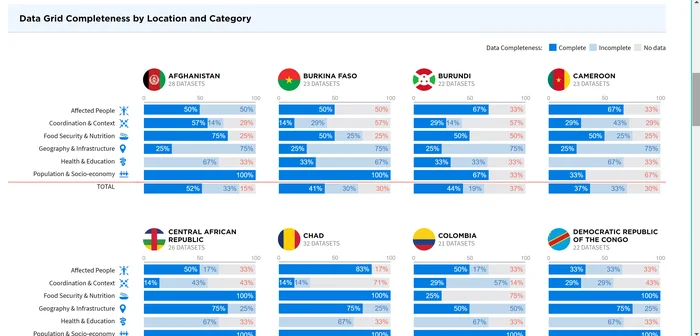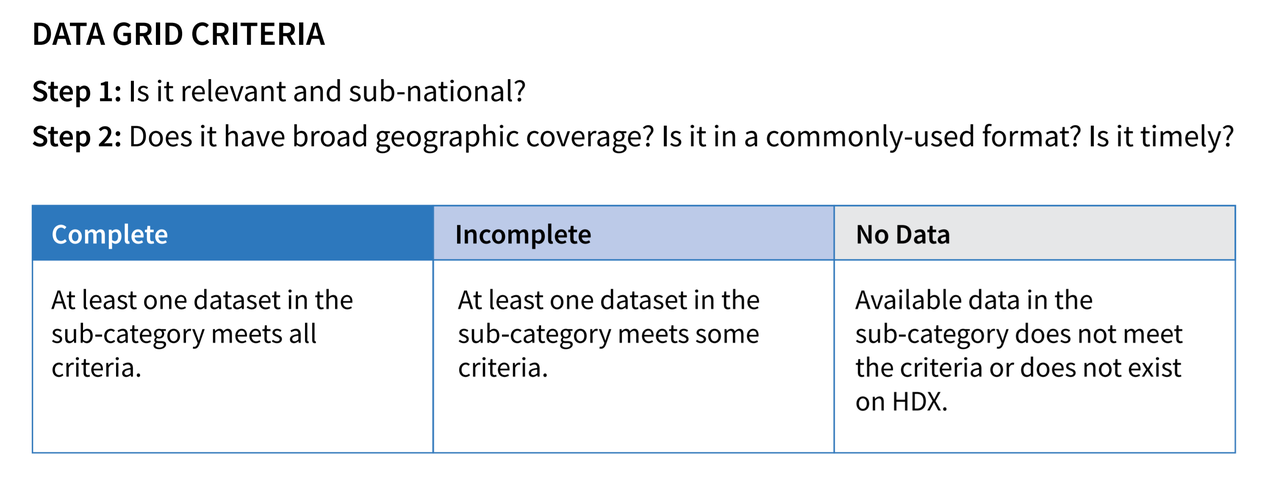The State of Open Humanitarian Data 2021
We interviewed David Megginson, Standards Lead at OCHA’s Centre for Humanitarian Data about their latest report: The State of Open Humanitarian Data 2021.
What is the State of Open Humanitarian Data 2021 report about?
This report increases awareness of the data that’s available to inform humanitarian operations around the world and to highlight what is missing. In the second year of producing this report, it is evident that relevant, complete and timely data is essential for understanding current humanitarian crises and anticipating what comes next.
In the report, the Centre for Humanitarian Data estimates that at the start of 2021, just 51 percent of relevant, complete crisis data is available for humanitarian operations in 27 locations.
What data was used to inform this report?
We used data available from OCHA’s Humanitarian Data Exchange (HDX) platform. This is because as the principal repository for humanitarian data, HDX is a useful proxy for measuring data activity on a global scale.
We used HDX’s Data Grids on humanitarian operations in 27 locations. They bring together the most important crisis data into six categories: affected people; coordination and context; food security and nutrition; geography and infrastructure; health and education; and population and socio-economy.

Data Grids are available for 27 humanitarian operations on OCHA’s Humanitarian Data Exchange (HDX) platform.
The Data Grids show the ‘completeness’ of data in each humanitarian operation based on three categories:

How did IATI data play a role in this assessment on the availability of humanitarian data?
At the start of 2021, our Data Grids used datasets from 32 sources, including IATI. IATI activity (project) data fits into the Coordination & Context category, under its subcategory called ‘3W — who is doing what where’. The primary source of activity information is 3W (Who? What? Where?) activity reports collected by OCHA on behalf of its humanitarian country teams, and we supplement the 3W with IATI data.
The Centre was able to include IATI data in this report because of a collaboration with the IATI Technical Team in 2019. Together we produced simplified country-specific views of IATI data using the Humanitarian Exchange Language (HXL), a spreadsheet-based format that anyone can open or edit easily.
We use IATI data in UN OCHA’s Humanitarian Data Exchange (HDX) platform because it provides relevant, useful information to those working on humanitarian operations.
IATI was mentioned in the report’s case study on Mali. How did IATI data add value to this case study?
We included the country deep-dive for Mali to show an example of the individual datasets included in a Data Grid (p.17). The HDX Mali Data Grid includes IATI activity data in the Coordination & Context category, and IATI data has contributed to Mali having the highest degree of data completeness (tied with Chad at 70%) across the 27 locations that we monitor.
Why is IATI data useful to those working in the humanitarian sector?
We use IATI data in UN OCHA’s Humanitarian Data Exchange (HDX) platform because it provides relevant, useful information to those working on humanitarian operations. While we use OCHA 3W reports as our primary source of activity information in HDX, IATI provides a useful complement in four ways:
- It includes development as well as humanitarian activities, providing a broader context for in-country coordination.
- It is continually updated, so it may have more recent information than some 3W reports.
- It includes activities by organisations who work outside of the UN coordination system.
- It is available for all countries, even if they do not have an active humanitarian response.
What progress have you made in using IATI data in HDX following your pilot in 2019?
We’ve made great progress — we have an up-to-date IATI dataset for every country, such as Current IATI aid activities in Venezuela. To make the data relevant to humanitarians, we simplify it into spreadsheet format, and include only active activities, not past/completed or future/planned ones.
Are there any updates on the Centre for Humanitarian Data’s work to integrate IATI data into OCHA’s Financial Tracking Service (FTS)?
We previously delivered a pilot showing that IATI can be successfully ingested as semi-automated data for OCHA’s Financial Tracking Service (FTS). It was promising that during the pilot, organisations who publish IATI data were eager to participate and willing to make necessary changes to their data to enable the integration. FTS is currently assessing how to move from the pilot into broader use of IATI for reporting on humanitarian funding.
How can IATI continue being useful to humanitarian data users?
We’re continually engaged with stakeholders about how we can improve the usability of IATI data within the humanitarian sector. It is important for organisations to publish their data according to the IATI Humanitarian Guidance.
In particular I’d like to emphasise that organisations
- consistently use the humanitarian marker;
- include humanitarian cluster codes (sector vocabulary 10) as well as the OECD DAC sector codes (sector vocabulary 1 and 2);
- publish timely data; and
- share subnational geolocation on activities (humanitarian data is typically geolocated at least to admin level 2 within a country).
By following these steps, organisations can make a significant difference in the value of their IATI data for humanitarians.